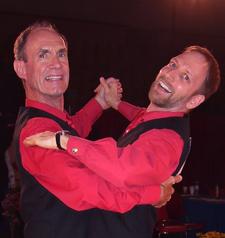“I try to build the routines so that it looks like two guys dancing, not one man doing the men’s steps and one doing the women’s steps,” says Steve Groleau, an Ottawa-based ballroom dancing coach.
Ballroom dance has been a part of Groleau’s life for over 20 years. At the end of the month, he’ll be heading to Copenhagen to judge the sport at the World Outgames. More than 300 dancers from 17 countries signed up for this year’s event.
There, a pair of his Ottawa students say they are fulfilling lifelong dreams simply by competing.
When Blake Proudfoot, then a square dancer, first encountered ballroom dancing at the 1998 Gay Games, he was thrilled.
“I was blown away by it completely. I raved about it when I got back to Canada,” Proudfoot says.
He went looking for a class in Ottawa and was directed by a friend to Paul Lafleur, the founder of the city’s same-sex ballroom club Waltzing Out/Le Pied Gai. In 2002, the two began training with Groleau, a veteran of ballroom dancing.
Lafleur, who danced competitively with female partners in his youth, says the decision to form a male duo came down to being “honest” in the way he expressed himself through ballroom dance, which often involves close contact between partners.
“I certainly wouldn’t mind dancing with women, but I thought ‘wouldn’t it be romantic to dance with a gorgeous man?'” he explains. “It seemed more honest, more real.”
While there are variations from one competition to the next, dancesport events are run much the same for both opposite-sex and same-sex pairs. Internationally, a standard event has dancers perform the quickstep, slow waltz and tango, while advanced pairs also master the foxtrot and Viennese waltz. Other recognized forms include Latin American dance, which includes jive, rumba, samba and paso doble, the cha-cha and the ten-dance, which is comprised of both standard and Latin American steps.
Couples are grouped in heats according to their skill ranking, which also determines what steps they are allowed to use. In a heat, all dancers perform at the same time, and each routine lasts no longer than 90 seconds, creating a hectic atmosphere that requires couples to communicate and improvise.
“You have an idea [of] what the dance is going to be then, all of sudden, other dancers will pop up on the floor in front of you,” Lafleur says. “You have to do variations so that you don’t run into anyone or have to stop.”
Judges either score or rank the couples based on aspects like timing, footwork and the proper relationship between the lead and follow.
Same-sex ballroom dancing has adopted its own twists, however. While men are normally expected to lead their female partners, the gender distinction becomes blurred when two men or two women dance together, says Groleau.
“A same-sex couple will often switch leads in the middle of a dance, which makes the entire dance look very different,” he says.
The physical similarity between same-sex dancers also creates a more complementary pairing, Groleau says, which he uses to bring out “balance of the individual and couple.”
Unfortunately, many in the dancesport community take a dim view of those who would challenge tradition in these ways. The International DanceSport Federation (or IDSF), which is recognized by the International Olympic Committee as the main organizing body for amateur ballroom dance, enforces a strict rule that only allows couples consisting of “a male and female partner” to compete at its events. Many other organizations, including the Canadian Amateur Dance Association, have followed the IDSF’s lead with their own bans on same-sex couples. Questions sent to the IDSF regarding this policy were not returned in time for publication.
The IDSF also takes the additional step of barring its members from attending unsanctioned competitions on threat of suspension. The rule is intended to enforce the IDSF’s role as the governing body for international dancesport, but it also prevents dancers and judges from competing in events that allow same-sex couples.
Despite the regulations, dancesport has developed such a large following in Europe that organizers of same-sex events there say they don’t need any validation from international bodies.
But in North America, the sport hasn’t been as quick to catch on — the North American Same-Sex Partner Association wasn’t formed until 2007, and there’s only one dedicated same-sex ballroom studio in Canada, located in Vancouver. Lafleur says, here, segregation damages the sport by forcing a small number of participants to choose sides.
That’s less of a concern in Europe, where gay dancers have been competing in their own events for years, says Dörte Lange, co-president of the European Same-Sex Dance Association, which was founded in 1996.
“I think that I represent the opinion of [the] majority of German same-sex couples when I say that we don’t have the intention to compete in the same competition against heterosexual couples.”

 Why you can trust Xtra
Why you can trust Xtra


